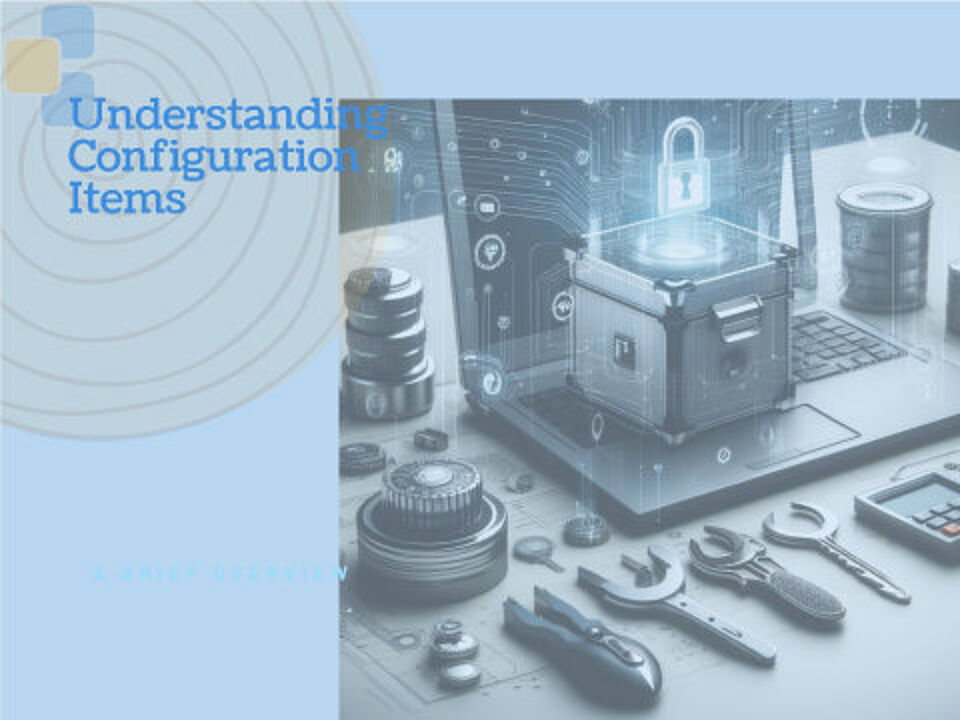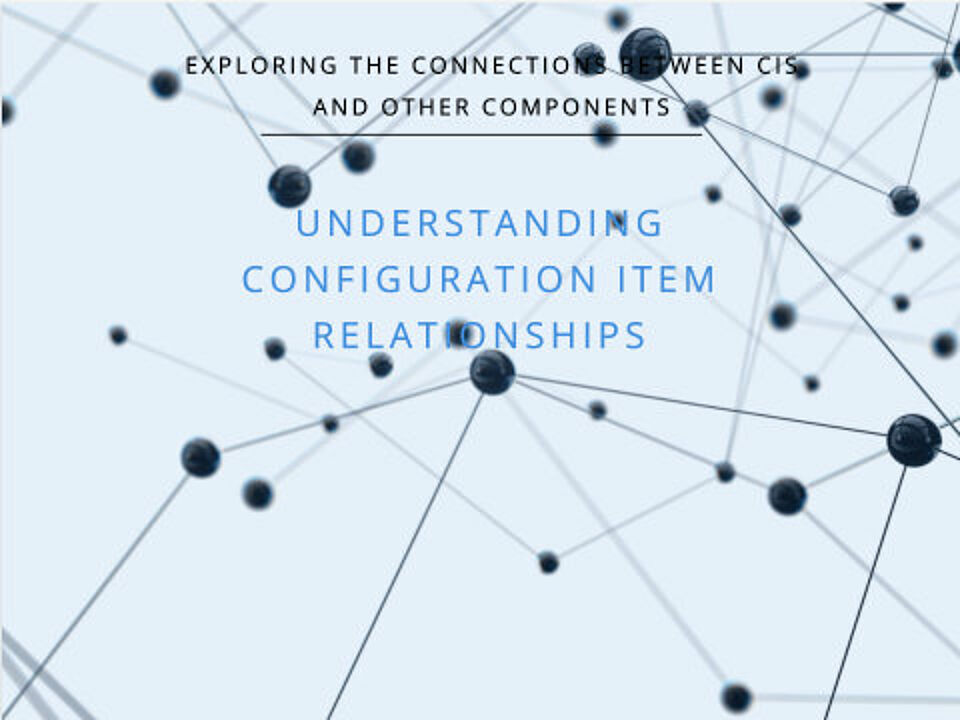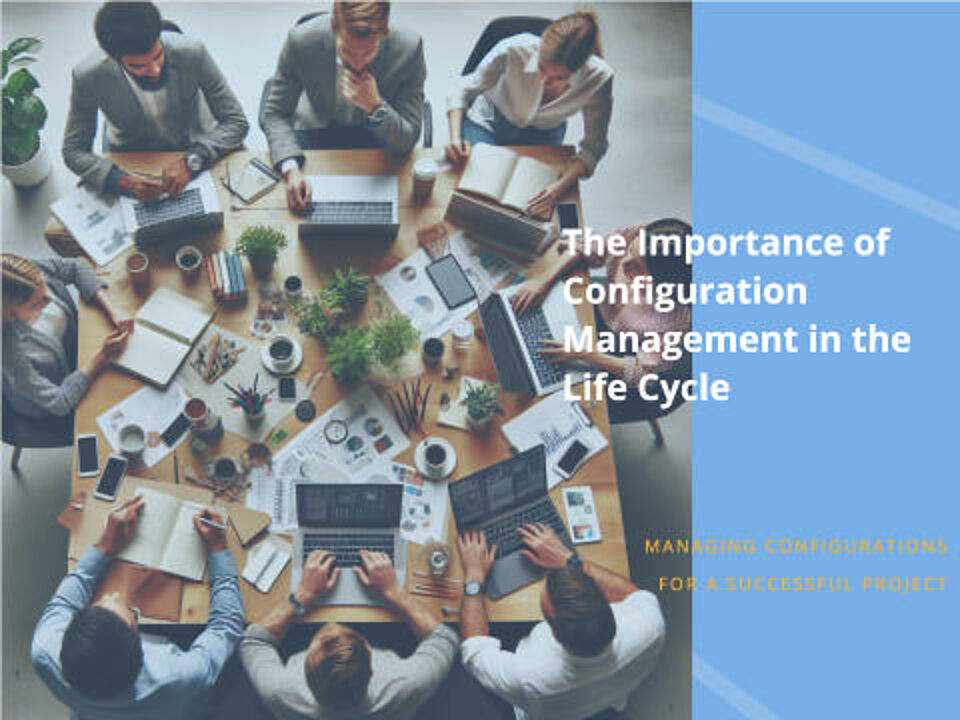
Author: Ralph Bockisch
Creation: 27.01.2020, last change: 13.06.2025
Table of contents
What is the basic concept of a configuration item?
What are the relationships between configuration items and other components?
What role does configuration management play in the entire life cycle?
In the digital age, where IT systems and networks form the backbone of modern organisations, understanding and managing the myriad components that make up these complex structures is critical to success and efficiency. A central object in this management process is the so-called configuration item. But what exactly is a CI and why does it play such an important role in IT infrastructure and IT management?
A configuration item can be defined as any component that is essential for the provision of IT services and therefore needs to be identified, managed and monitored. This includes physical components such as servers and routers, software applications, but also services and documentation that are relevant to the functioning and management of the IT infrastructure. The systematic recording and monitoring of these elements enables organisations to manage changes efficiently, identify and resolve problems quickly and ensure compliance with internal and external regulations.
The importance of CIs extends beyond the mere inventory. They are the foundation for configuration management, a process that aims to keep information about IT assets and their configurations up-to-date and accurate. This is crucial for risk management, security analysis and the optimisation of IT-services. In a landscape characterised by rapid technological advances and constant change, effective management of configuration items enables organisations to strategically deploy their IT resources to support their business objectives.
In the following sections, we will take a closer look at the basic concepts of configuration items, examine their types and the processes of handling and managing them, as well as their relationships with other IT components and their role in the overall IT management lifecycle.
![[Translate to English:] EcholoN Blog - CI - Was ist das grundlegende Konzept eines Configuration Items? EcholoN Blog - CI - What is the basic concept of a configuration item?](/fileadmin/_processed_/e/7/csm_EcholoN-Blog-CI-what-is-the-basic-concept-configuration-item_4b00b24c09.jpg)
What is the basic concept of a configuration item?
The concept of a configuration item is fundamental to understanding and managing the IT infrastructure in organisations. CIs are the building blocks that form the basis for effective configuration management and thus for the stability and security of IT services.
Definition of a configuration item
A configuration item is any identifiable unit that is essential for the provision of IT services and is placed under the control of configuration management. This can be hardware, software, a virtual system, a network element, a document or a combination of these. A CI not only contains the physical and logical components of the IT infrastructure, but also the relevant information and data required to manage these components. This includes configuration data, dependencies on other CIs and historical data on changes and updates. The precise definition and identification of CIs enables structured and organised management of IT resources.
Necessity of configuration items in management
The management of configuration items is a highly relevant aspect of IT management that helps to maintain the integrity of the IT infrastructure and support the provision of high-quality IT services. By identifying and controlling CIs, IT teams can systematically plan and implement changes, accurately analyse the impact of incidents and develop effective recovery strategies in the event of a failure. Managing CIs also helps to fulfil compliance requirements and provide detailed documentation for audit purposes. Without careful management of configuration items, IT environments would quickly become cluttered, which could lead to inefficient processes, increased risks and potential security vulnerabilities.
Types of configuration items
Configuration items can be divided into different categories depending on their function, purpose and complexity. The most common types of CIs include
- Hardware and virtual components: These include servers, computers, network devices, printers and other physical devices used in the IT infrastructure.
- Software applications: This includes operating systems, application software, databases and other software components that run on the systems.
- Documentation: Important documents such as procedural instructions, guidelines, service level agreements (SLAs) and configuration documentation.
- Services: IT services provided to the organisation or end users, including cloud services and external services.
The classification and management of these different CI types require specific strategies and tools to ensure that the IT infrastructure is managed efficiently, securely and in line with business objectives.
How are configuration items processed and managed?
The effective processing and management of configuration items is critical to maintaining the integrity and performance of the IT infrastructure and supporting business processes. In this section, we will look at the processes and best practices for editing CIs, managing them in the Configuration Management Database (CMDB) and the importance of categorising CIs.
Editing configuration items
Editing configuration items involves updating, changing and maintaining CIs to ensure they always meet current requirements and standards. This includes
- Identification and documentation: each CI must be clearly identifiable and all relevant information must be accurately documented, including the specifications, version, location and any associated dependencies.
- Change management: Changes to CIs must be controlled through a formal process that includes the assessment, approval and documentation of changes to minimise unintended impacts on IT services.
- Monitoring and review: CIs should be regularly monitored and reviewed to ensure their compliance with the defined standards and guidelines and to identify potential problems at an early stage.
Management of configuration items in the CMDB
The Configuration Management Database is a central repository that stores all information about the configuration items and their relationships to each other. The effective management of configuration items in the CMDB includes
- Recording and updating: all CIs and their changes must be recorded in the CMDB and kept up to date to ensure an accurate and comprehensive view of the IT infrastructure.
- Relationship management: The CMDB makes it possible to track the relationships and dependencies between different configuration items, which is essential for planning changes, resolving incidents and performing root cause analyses.
- Quality assurance: Regular reviews and audits of the CMDB are necessary to ensure the accuracy and completeness of the data it contains.
Categorisation of configuration items
The categorisation helps to classify CIs based on their properties, functions or their role in the IT infrastructure. This structuring is important in order to:
- simplify administration: By categorising CIs, IT teams can apply specific management policies and practices to different CI types, increasing management efficiency and effectiveness.
- Support risk assessment: Classification of CIs enables targeted risk assessment and prioritisation of actions based on the criticality of CIs to business processes.
- Facilitate compliance and reporting: A clear categorisation supports compliance audits and reporting by providing a structured overview of CIs.
Editing and managing configuration items is an ongoing process that requires careful planning, monitoring and adjustment to keep the IT infrastructure in line with changing business needs and technological developments.

What are the relationships between configuration items and other components?
The interactions and connections between configuration items and other elements within the IT infrastructure are critical to understanding and effectively managing IT services. These relationships form the backbone of robust IT Service Management (ITSM) and help to optimise service delivery.
Relationship between configuration items and services
Each IT service is made up of different CIs that interact with each other in a structured way to provide the service. These relationships can be of different nature:
- Structural relationships: This involves the physical or logical composition of the service, such as the connection between a server and the application service hosted on it.
- Dependency relationships: These show how CIs are dependent on each other to support a service. A failure of a critical CI can therefore affect the associated service.
- Information relationships: These refer to the information flows between CIs, such as configuration data or status updates, which are important for service performance.
Detailed knowledge of these relationships enables IT teams to understand the impact of changes to CIs on IT services, better manage risks and improve service quality.
The process of linking configuration items
The process of linking configuration items involves identifying and documenting the relationships between different CIs within the IT infrastructure. This is an important step in configuration management that includes the following aspects:
- Identifying relationships: Firstly, the relationships between CIs must be identified, which requires a thorough analysis of the IT infrastructure and the service architecture.
- Documentation in the CMDB: The recognised relationships are documented in the Configuration Management Database. This includes information about the type of relationship, the CIs involved and relevant attributes.
- Visualisation: Relationships between CIs are often visualised in the form of diagrams or service maps to enable a clear understanding of the service structures and dependencies.
- Updating and checking: The links between CIs are dynamic and can change over time. Regular reviews and updates are required to ensure the accuracy and relevance of the documented relationships.
Through the systematic process of linking CIs, organisations can gain an in-depth understanding of the structure and dynamics of their IT services, which forms the basis for effective IT service management.

What role does configuration management play in the overall life cycle?
The management of configuration items or configuration management plays a central role in the IT infrastructure and in the entire life cycle of IT services. It ensures stability, security and efficiency in the provision and maintenance of IT services. Configuration management is the process of identifying, organising, monitoring and maintaining the components of the IT infrastructure.
Role of configuration management in change processes
Configuration management is relevant for managing changes in the IT infrastructure. It enables:
- Risk assessment: detailed knowledge of CIs and their dependencies helps to assess potential risks associated with changes.
- Planning and approval: Configuration Management provides the necessary information to carefully plan, test and approve changes before they are implemented.
- Impact analysis: It enables the impact of proposed changes on IT services and business processes to be analysed in order to minimise undesirable consequences.
- Documentation and tracking: All changes to CIs are documented and tracked, enabling effective monitoring and subsequent review.
Importance of the configuration management system
A Configuration Management System (CMS) is an integrated set of tools and databases used to manage CIs and their information. The importance of a CMS in the lifecycle of IT services includes
- Central source of information: a CMS serves as a central source of information for all CI details and relationships, which improves information consistency and accessibility.
- Support of ITSM processes: It supports essential IT service management processes such as incident management, problem management and change management by providing relevant CI information.
- Improving decision-making: By providing accurate and up-to-date information about CIs, a CMS helps in making informed decisions regarding IT infrastructure and services.
- Compliance and security: An effective CMS supports compliance initiatives and security management by monitoring configurations and ensuring that they comply with established standards and policies.
Configuration management and the associated system are therefore essential for maintaining control and oversight of the IT infrastructure and ensuring efficient and secure IT service delivery throughout the lifecycle.
Perhaps also interesting:
- Overview of configuration management in the IT infrastructure
- EcholoN CMDB - Configuration Management Database complete solution
- IT Service Asset Management - Example & Advantages
- ITSM - IT-Service-Management-Software EcholoN
- Blog-Artikel: Configuration Management, CMDB and Co
- Blog-Artikel: What is an IT service? IT services for companies - definition - function - best practices
- Blog-Artikel: Service Asset Management
- Blog-Artikel: Service mapping: A simple guide
